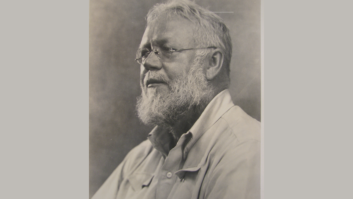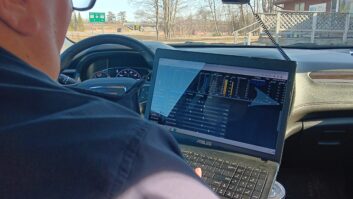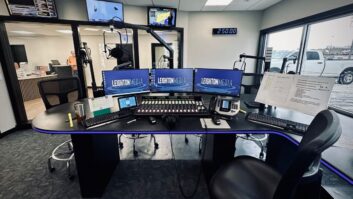Night at Brant Rock
Nov 1, 2006 12:00 PM, By Allen J. Singer

Fessenden in his later years. Courtesy of the State Archives of North Carolina.
While Guglielmo Marconi sent the first message by wireless in 1896, Canadian inventor Reginald Fessenden saw greater potential. Fessenden was Thomas Edison’s chief chemist at Menlo Park just a few years before, and throughout the 1890s he independently researched the science of electromagnetism.
Fessenden studied the design of Marconi’s method of transmitting wireless. While it unquestionably did the job, he noted its flaws. The telegraph key and spark-gap transmitter sent a �whip-crack of the ether� on no specific frequency of the electromagnetic spectrum. The telegraph signals could be picked up by any receiver anywhere. This was fine for ships at sea, but not for military communication or anything else requiring privacy. Fessenden’s idea was to send continuous waves of electrical signal across the ether that could carry sounds of voices and music.
Scientists proposed different theories of how wireless signals were transmitted on the ether. Fessenden’s �gliding wave� theory stated that radio waves were �attached to and guided by the earth’s surface.� High frequency electrical waves, he explained, could propagate from a grounded transmission system and follow the curvature of the Earth. Both earth-based electric currents and magnetic and electrostatic fields in the air would carry the waves.
An early opportunity
The U.S. Weather Bureau hired Fessenden in 1900 to research and invent a wireless device to communicate with outlying stations tracking severe weather. He set up shop on Cobb Island on the Potomac River in Washington, DC, and developed an electrolyte-based detector he called the �barreter.� This device consisted of a metal plate immersed in a liquid solution that could generate a continuous electrical wave when current was applied.

Fessenden (seated at right) in the lab. Courtesy of the State Archives of North Carolina.
The tests in 1900 resulted in spoken words transmitted wirelessly and received one mile away. Fessenden’s assistant pressed his earphones to his ears and underneath the roar of static, he heard faint words: �One, two, three, four. Is it snowing there, Mr. Thiessen?� the voice said. �If it is, telegraph me back.� It worked. The Weather Bureau was impressed with his results and agreed to continue financing his experiments. He patented his method in 1901.
The barreter’s biggest problem was that it was plagued by atmospheric distortion. Fessenden looked for ways to improve it and examined Nikola Tesla’s research on electromagnetism and generation of high frequency waves using alternating current. He wanted to design his own system using a mechanical generator to transmit 100 kilocycle electrical waves through the air; in simpler terms, amplitude modulation. Later that year he moved his research base to Roanoke Island in North Carolina.
While there, he kept innovating. In 1902 he combined two signals to produce one with a new frequency. He named the circuit the �heterodyne,� after �other force� in Greek. His primitive equipment, though, could not produce the precise frequencies the circuit required.

The alternator generator at Brant Rock. Courtesy of the State Archives of North Carolina.
Two Pittsburgh investors approached Fessenden in 1902. They had big plans to turn the results from Fessenden’s experiments into a commercial service, and to compete with Marconi for transatlantic operation. With their financing, he formed the National Electric Signaling Company. Engineers at General Electric were hired to design and build the required 100 kilocycle alternator. He erected a tower and installed the alternator at a station at Brant Rock near Boston in 1904.
The big night
General Electric’s alternator worked but reception was nonexistent during daylight hours. After much fine-tuning, fishing boats started receiving his test signals in 1906. Inspired by the success, Fessenden scheduled a holiday radio program and asked phonograph companies to donate records. In his test broadcasts late that year, he announced the special Christmas Eve program to his several listeners.
While the stockings were hung by the chimneys with care on the mainland, shipboard wireless operators were surprised to hear violin music instead of the usual dots and dashes. When the music ended, the crackly voice of the world’s first disc jockey floated prominently through the static. �If anyone hears this,� it said, �please write to Mr. Fessenden at Brant Rock.� Fessenden himself then played O, Holy Night on the violin � singing the last verse; read passages from the bible; and played Handel’s Largo from the Serse opera on a phonograph record. He repeated the program on New Year’s Eve. To him, at least, it was a success.
The general public never learned of it, though. Only a few fishermen, naval officers and wireless hobbyists were privy. His backers declared their interest in transatlantic telegraphy and walked out. Disappointed in the overall result, Fessenden decided radio would never serve as a form of entertainment.

The tower at Brant Rock. Courtesy of the State Archives of North Carolina.
Fessenden accomplished what he had set out to do: he proved voice and music could be carried by continuous wireless waves. Others, though, deserve credit as well. Thomas Edison invented the hot-cathode vacuum tube in 1884. Borrowing on the tube’s �Edison effect,� Ambrose Fleming created and patented the diode �valve� tube in 1904, which forced directional current flow. Lee de Forest added a third electrode to Fleming’s diode in 1907 and called it the Audion tube. Later, Edwin Armstrong experimented with the Audion tube and designed the first audio amplifier, the regenerative circuit. Armstrong took the modified Audion tubes and wired a circuit that received and produced RF waves � Fessenden’s mechanical alternator had just been made obsolete by the vacuum tube. Later in 1916, Armstrong combined the heterodyne with his regenerative circuit and created the �superheterodyne,� a four-stage amplifier whose basic design is still used to this day.
Singer is a freelance writer and a former radio engineer in Cincinnati, www.allensedge.com.
Dec. 24, 2006, will mark the 100th anniversary of Fessenden’s audio broadcast, and as the radio industry recognizes the contribution of this achievement next month, Radio magazine will recognize the top 100 technology achievements that helped shape radio broadcasting. Look for this special feature next month in Radio magazine.










